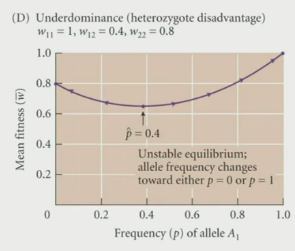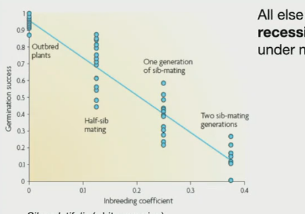EVE 100 Midterm 2
1/22
There's no tags or description
Looks like no tags are added yet.
Name | Mastery | Learn | Test | Matching | Spaced |
|---|
No study sessions yet.
23 Terms
Dominance
describes the effect of an allele on a phenotypic character when it is paired with another allele in a heterozygote condition —> higher fitness
takes longer to reach fixation since the recessive alleles hide in the background
Advantageous dominant alleles increase in frequency more rapidly since it is expressed in both homozygous and heterozygous genotypes

Recessive alleles
Hide behind the dominant allele even when advantageous
advantageous recessive alleles take a long time to increase in frequency since when at lowe frequencies, it is present in the heterozygous form → invisible to selection
Advantageous recessive alleles can reach fixation since they hide in the background
After the advantageous dominant allele attains high frequency, the alternative disadvantageous recessive allele is slowly eliminated → rare recessive alleles occur mostly in heterozygous forms -→ invisible to selection

Fitness
Measure of the “relative success of a population, genotype, and alleles
measures how often thinsg reproduces
defined by the probability of survival and the avergae number of offspring
best applied to a set of entities → all individuals in a population or individuals with a given genotype
MOST fit genotype = relative fitness of 1
LEAST fit genotype = relative fitness of 1-s (s = selection coefficient)
HETEROZYGOUS genotype = relative fitness of 1- hs (h - dominance coefficient) → determines how far the heterozygous genotype is from the homozygous phenotypes
h = 0 → A1 is dominant
h = 0.5 → A1 is additive
h = 1 → A2 would be dominant (A1 is recessive)
Finding relative fitness
absolute fitness/the highest absolute fitness —> needs to be ain a decimal form less than or equal to 1
Selection coefficient
finds how fit something is from the MOST fit organism
most fit h and s coefficients help us understand how dominance affects fitness
Decent of modification
genetic changes in populations over timeM
Mutations
Mutation rates per base pair are low —> but the number of new mutations per individual may be large
humans have a mutation rate of ~2.5 × 10^-8 mutations per generation → BUT the number of new mutations PER individual may be large
Humans have around 160 new mutations per transmission (each of us has 160 unique mutations that other people do not have)
Mutations are random but common
Mutation types:
single base pair mutations
translocations
deletions/duplications
whole genome duplications
inversions
transposable elements
retrovirus insertions
chromosome fission and futsion
Mutations can either be beneficial, deleterious or neutral —> they can also have small or large effects —> they can also be dominant or recessive
most mutations are directly selected out of a population
Distribution of fitness effects (DFE)
this looks like a continuous ditribution
most effects of mutations are small —> most new mutations reduce fitness ( a little)
fitness effects of mutations —> less than 1 = deleterious and decrease fitness and fitness greater than 1 are probably beneficial mutations
Heterozygosiry = H
this is the fraction of sites that are heterozygous → more heterozygous genotypes = higher heterozygosity
humans have a heterozygosity of 0.1 → therefore diversity within humans are low
higher heterozygosity = lower offspring (ex., hybrids survive but rarely reproduce)
3 reasons for how genetic and phenotypic polymorphism is maintained
→ polymorphism: different phenotypes = different genotypes
balancing selection: selection sometimes acts to maintainvariation
Mutation selection balance: the rate of mutation and the rate of selection are both similar emough that the mutations are not gotten rid of due to the rate of new mutations being too fast
mutation-drift balance ( neutral theory): genetic drift
Balancing seelction
when selection can maintain balanced polymophism in a population
overdominance or heterzygote advantage: Heterozygotes for an allele have a higher fitness than either homozygote
negative frequency-dependent selection: selction favors rare morphs —> states that it is better to be different → this increases trait diversity
spatially or temporally variable selection: variation in selection across space or time maintains genetic variation
Overdominance and Underdominance
Best genotype = combination of 2 different types of alleles
over mean fitness when there is an intermediate frequency of alleles → p is in the middle → this maintains polymorphism for more favorable genotypes → heterozygote is the BEST

Underdominance: when the heterozygote individual is the worst → the AA or aa genotype is the best

Example: sickle cell anemia → the patient is less susceptable to malaria when they have a heterozygous genotype for those with mild anemia (Ss = mild anemia) → (SS = sickle cell anemia) → thisis because the RBCs have shorter life spans → this gives the plasmodium less time to reproduce
If a heterozygote has the HIGHEST fitness = heterozygote advantage = overdominance
Negative frequency-dependent selection
genotype/phenotype has a fitness advantage when it is rare, but its fitness decreases as it becomes more common
fitness is negatively correlated with frequency → lower frequency = higher fitness
rarity is an advantage
Spatially and temporally variable selection
variation in a phenotype of genotype is maintained by variation in selection patterns across environments → one allele has a fitness advantage in one environment while another allele has a fitness advantage in another environment
e.g. Bird beak shapes → change yearly based on drought → smaller or bigger → adapt to time and environmental conditions
spatial and temporal selection can occur at the same time
local adaptation = a form of variable selection
Things that determine the amount of variation in a population
mutation selection balance
mutation and inbreeding (gene flow) between populations
Ge
Gene flow
homogenizes allele frequencies UNLESS selection prevents it → if it does then we get a migration selection balance → how gene flow (migration) and natural selection interact → equilibrium that forms when:
Migration brings alleles into a population → continuously introduces new variants to a population
Selection works against those alleles
two forces balance out so the allele stays at an intermediate frequency instead of being lost or fixed
If selection eliminates deleterious variants, variation can be maintained
Mutation selection balance
mutations continuously introduces new variants to a population → if selection eliminates the deleterious mutations → variation can be maintained
mutation = MAIN SOURCE or genetic variation
stronger selection = rate of taking away deleterious variatns in the population is faster
Weaker selection = rate of taking away deleterious variants in the population is slower
Mutation selection equilibrium
Deleterious alleles that dont have a too strong of an effect in the heterozygote can be maintained at low frequenes in the population → recessive deleterious alleles
Mutation introduces new variation into a population
Random genetic drift determines heather a neutral allele will be fixed or (usually) lost
At equilibrium, there is a balance between mutation and genetic drift
Inbreeding depression
reduces fitness of inbred individuals due to deleterious mutations
reduced fitness in offspring that results from mating between relatives.
more recessive mutations should segregate at high frequencies under mutation-selection balance

Expression of deleterious recessive alleles
Normally, recessive harmful mutations are “hidden” in heterozygotes.
Inbreeding makes offspring more homozygous, so these bad alleles get expressed.
Example: genetic disorders in royal families with lots of cousin marriages.
Loss of heterozygote advantage (overdominance)
Some genotypes (heterozygotes) are fitter than either homozygote
nbreeding reduces heterozygosity, lowering this benefit
The closer the parents are to each other (genetically) → the lower of the mean lifespan of children → this is due to everyone having these recessive negative deleterious mutations hiding in our genomes under our dominant alleles
Polymorphism
Overdominance
Having A2 always better than A1 → directional selection
Overdominance: heterozygous genotype is the most fit → aka heterozygous advantage
Eg. sickle cell anemia → maintains variation of an allele in a population
Mutation - selection balance → reasons we might see variation in a population
“Giant sink of all of our alleles in a population”
→ lots of allele variation = full sink
→ little allele variation = empty sink
Need to induce mutations (faucet → fills the sink up)
New alleles → everyone looks more different
Selection: can remove alleles in our population (drain) → “directional selection” that is natural selection
We can get an equilibrium of our variation → called the Mutation Selection Equilibrium
We need to know μ: rate of mutation
s = selection coefficient
h = dominance coefficient
q(eq) = mutation rate (μ)/ ((selection rate(s) * dominance coefficient (h)))
Balance between mutation → Genetic drift
we dont believe in selection → we believe in a more random process where we take variance outside of the population
instead of selection we get drift
mutation drift equilibrium
Ne = (N = number of things we see → E = means effective)
Ne = effective population size → if mutations add things to a small population → “size of an idealized population (one that follows Hardy–Weinberg assumptions perfectly) that would experience the same amount of genetic drift, inbreeding, or loss of diversity as the real population”
larger population size = more even probability of allele frequency
genetic drift → more effective in smaller populations
neutral alleles are alleles that don’t impacts fitness → synonymous mutations and codons → change in third codon doesn’t change the fitness of an organism
selection
Neutral theory of molecular evolution
most mutations are deleterious and are lost immediately
Most observed molecular polymorphism and genetic substitutions are neutral → consistent with high levels of genetic polymorphism and molecular clock
Frequency of neutral alleles are controlled by:
Mutation rate
Genetic rate